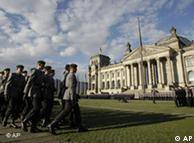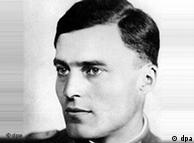World War II | 20.07.2009
Germans commemorate failed plot to assassinate Hitler
Politicians and soldiers laid wreaths at the Berlin Resistance Memorial Center at the Bendler Block, seat of the Defense Ministry, where Colonel Claus Schenk Count von Stauffenberg was executed alongside three fellow plotters on July 20, 1944.
Victims of Nazi Germany were also remembered at Ploetzensee, a lake on the outskirts of Berlin where more than 2,500 people were killed between 1933 and 1945.
Speaking at Ploetzensee, German Economics Minister Karl-Theodor zu Guttenberg said resistance to Nazi Germany came from all areas of society, including trade unionists, politicians, scientists, public servants and members of the Jewish community.
"July 20 is a warning to the future, and not an annually recurring nostalgic event," Guttenberg said.
Later on Monday, Chancellor Angela Merkel and Defence Minister Franz Josef Jung are to address around 400 young Bundeswehr recruits taking their military oath in front of the Reichstag building. The ceremonial oath is taken annually on July 20 in commemoration of the failed assassination attempt.
Anti-military demonstrators seized the opportunity to protest against war at a rally on Potsdam Square, out of earshot of the parliament building. Police had previously banned them from marching through Berlin's Tiergarten park.
Assassination plot
 Bildunterschrift: Großansicht des Bildes mit der Bildunterschrift: An historic date and place for the Bundeswehr soldiers' swearing-in ceremony
Bildunterschrift: Großansicht des Bildes mit der Bildunterschrift: An historic date and place for the Bundeswehr soldiers' swearing-in ceremony
On June 6, 1944 (D-Day), the Allies had landed in France. Like many German professional military officers, Colonel von Stauffenberg had no doubt that the war was lost. Now was the time to act, and he believed that only an armistice could avoid more bloodshed and damage to Germany.
He and his co-conspirators tried to kill Adolf Hitler in order to start talks with the Western Allies for an end to World War II. He knew he was committing high treason under German law.
On July 20 the same year, Stauffenberg planted a bomb hidden in a briefcase in Hitler's Wolfsschanze eastern headquarters in Eastern Prussia during a briefing.
The bomb exploded but its impact was broken by a heavy table. Of the 24 people present, four died, but Hitler received only minor injuries. Meanwhile, Stauffenberg had already returned to Berlin. Convinced that the dictator was dead, he put in motion the so-called Operation Valkyrie, a plan originally conceived by the German military to suppress a possible rebellion during World War II which was adopted by the resistance plotters.
But the plan failed when it emerged later that evening that Hitler had survived the bomb attack. Among those sentenced to death with Stauffenberg, were General Friedrich Olbricht, the head of the group, as well as Albrecht Mertz von Quirnheim and Werner von Haeften.
The core group of plotters was executed that night by firing squad in the courtyard of the Bendler Block, then the General Army Office of the Army High Command.
dfm/db/dpa/AP
Editor: Neil King


Θυμούμαι την σκηνή οπως μετεδίδετο τότες από τις εφημερίδες.Αλλά νομίζω να υπάρχει και ταινία.Δύσκολη εποχή .
ReplyDelete